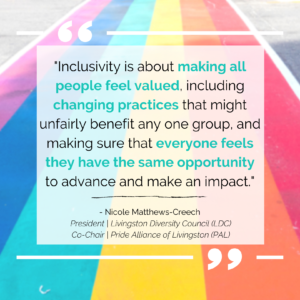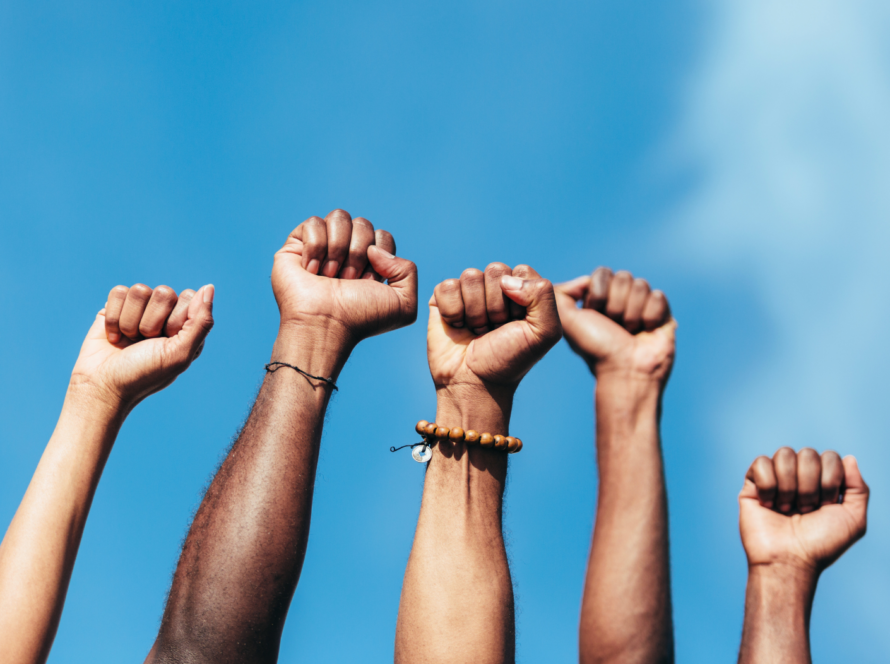June is Pride Month in the United States, and across the country, brands and businesses are taking this time as an opportunity to tell clients and customers that they stand with the LGBTQ+ community.
But inclusivity is more than just a trend to follow in the month of June, and our words only have as much impact as our actions. What happens when inclusivity efforts shift from a powerful show of support to passive rainbow-washing? What exactly IS rainbow-washing, and how can we avoid it?
We spoke with Nicole Matthews-Creech, President of the Livingston Diversity Council (LDC), and the Co-Chair of Pride Alliance of Livingston (PAL) about how businesses can actively support the LGBTQ+ community, and why these actions are so important – all year round.
To begin, we have to ask ourselves: what does true inclusivity look like?
According to Nicole, “inclusivity is about making all people feel valued, including changing practices that might unfairly benefit any one group, and making sure that everyone feels they have the same opportunity to advance and make an impact.” For a business to be considered truly inclusive, it must be providing or working to provide a welcoming, representative space (physically and digitally) for all individuals, including diverse and/or marginalized groups.
If a business truly desires to be inclusive,” Nicole says, “they need to commit to incorporating efforts toward inclusivity into their business platform, mission, corporate culture, and day-to-day operations throughout the year, not just when it is convenient for them or popular to do so.
In order to take our inclusive marketing efforts to the next level, now is a great time for brands and businesses to evaluate how they are incorporating inclusivity into their marketing strategies, campaigns, and company culture on a broad scale. It’s important to look beyond the surface, and consider whether your marketing efforts reflect the diversity and values of your audience. “More and more, individuals are eating, shopping, and visiting with their conscience,” Nicole says. “They want to feel good about who and what they are supporting, that their spending is making a difference – and this is no longer limited to donations to charitable organizations. If a business is not purposeful in the inclusivity of their marketing efforts, they may well find themselves with a dwindling customer base.”
But remember: true inclusivity is more than surface-level actions, and there’s a new term for what it looks like when a business says one thing in June, and does (or doesn’t do) another the rest of the year: rainbow-washing. Rainbow-washing is a performative act that gets its name from the popular use of adding rainbow colors and imagery to advertising, graphics, profile photos, and more.
In practicality, Nicole notes that rainbow-washing can take many forms such as “releasing limited-edition Pride merchandise with little or no information about whether any portion of the profits is going toward organizations that benefit the community; using LGBTQ+ employees as props in Pride-related marketing materials; supporting Pride month in June advertising and providing financial support to anti-LGBTQ+ organizations or anti-LGBTQ+ legislation throughout the year; and/or hiring LGBTQ+ creators for Pride projects and underpaying/not paying them for their work.”
Of course, there’s nothing wrong with a rainbow-colored profile photo! But in order to prevent these actions from becoming performative, or worse, exploitive, businesses must thoughtfully and deliberately follow up with inclusive actions that reflect their words and graphics.
So how can brands and businesses actively support inclusivity? We asked Nicole to give us her top five suggestions to help you get started today:
- Assess your business demographics. Who are your employees? Who are your leaders? Who is your target customer? Who is left out or not represented?
- Recognize biases that may be implicit within the type of business and the current culture of the organization. Review your hiring practices, your policies, and how your business is organized to do the work. Be honest with yourself, your employees, and your clients — and realize despite your best efforts, there are places where you can improve. Mistakes have likely been made. Look within to see how you can correct those errors. When we are wrong, we must learn, adjust, and do better.
- Invite and encourage diverse viewpoints. Challenge your employees to question in safe and respectful ways. Send a message to your employees that reinforces your belief system and the inclusive values you have built within your company.
- Develop clear standards and expectations – this does not mean that all is equal, it means that all is equitable. Be obvious in your messaging, upfront with your expectations, and respectful to your employees.
- Support inclusive organizations and causes. Select an organization or cause that holds meaning for you and your business and support it with your branding, fund their efforts, and empower employees to volunteer and take action! Advise your customers and clients on what steps you are taking, and plan to take, to make sure your company is inclusive and supportive of all people in your community.
We asked Nicole what it means to her, and the organizations she supports, when she sees companies being proactive with their inclusive measures – not just during Pride month, but all year.
“When a company is proactive with their inclusive measures, to me it means that they are putting people over profit. It means that they are willing to put aside their fears of what might not be the “popular” thing to do, but what is the “right” thing to do,” Nicole says. “Across the country, efforts are being launched to dehumanize and villainize our friends, family members, neighbors, and colleagues who identify as a part of the LGBTQ+ community. They need to know that they are welcomed, they are valued, and they are a critical part of the success of our humanity.”


